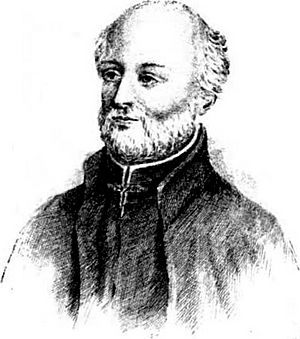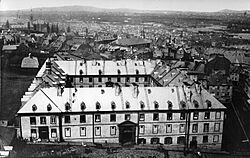Pierre François Xavier de Charlevoix facts for kids
Quick facts for kids
Pierre François Xavier de Charlevoix
|
|
|---|---|
 |
|
| Born | 24 or 29 October 1682 |
| Died | 1 February 1761 (aged 78) |
| Nationality | French |
| Occupation | Catholic priest, professor, historian, author, explorer |
| Known for | Histoire et description générale de la Nouvelle-France |
| Signature | |
Pierre François Xavier de Charlevoix (born October 24 or 29, 1682 – died February 1, 1761) was a French Jesuit priest, traveler, and historian. He is often seen as the first historian to write about New France, which was a French colony in North America.
Contents
About Pierre Charlevoix
Charlevoix's name can also be found as Pierre-François-Xavier de Charlevoix, Pierre De Charlevoix, or François-Xavier de Charlevoix.
Pierre's Life and Education

Pierre Charlevoix was born in Saint-Quentin, France, in 1682. His family was part of the French nobility, and his father was a deputy attorney general. His ancestors had important jobs in law and local government.
When he was 16, in 1698, he joined the Jesuit order in Paris. He studied philosophy from 1700 to 1704. From 1705 to 1709, Charlevoix was sent to the Jesuit College in Quebec City in the French colony of Canada. There, he taught French grammar.
After this, Charlevoix went back to Paris to study theology. He became a professor of literature. One of his students was the famous writer Voltaire. Charlevoix became a priest in 1713. In 1715, he published his first book. It was about the Catholic Church in Japan. He also included details about Japanese customs, clothing, politics, and nature.
Exploring North America
Charlevoix's work was paused when the King asked him to map the old borders of Acadia. This was a French colony that had been given to the British in 1713. He sailed from France in June 1720 and arrived in Quebec by September.
Because he knew a lot about North America, his mission was expanded. He was told to find a way to the "Western Sea" (the Pacific Ocean). He had to pretend he was just a traveler or missionary. The French King gave him two canoes, eight experienced companions, and some trading goods.
From Quebec, he traveled along the Saint Lawrence River and the Great Lakes. He went to Fort Michilimackinac, which is now in Michigan. He explored the southern part of Green Bay. He tried to reach the Illinois River from the Chicago River, but the water was too shallow. So, he went up the St. Joseph River to the Kankaki River, which flows into the Illinois River.
He traveled along the Illinois River until he reached the Mississippi River in 1721. He thought the meeting of these rivers was "the finest confluence in the world." He visited the Illinois Country and then traveled down the Mississippi to the Gulf Coast.
Journey to the Caribbean
From the Gulf Coast, Charlevoix took a ship to the island of Saint-Domingue in the Caribbean. However, his ship was wrecked near the Bahama Channel. He was helped by nuns from the Ursulines of Quebec. He later wrote a book about their founder, Saint Marie of the Incarnation. Charlevoix and his friends returned to the Mississippi River by following the coast of Florida.
His second trip to Saint-Domingue was more successful. He arrived in September 1722 and left for France at the end of that month. He landed in France in December. Charlevoix kept a detailed record of his whole journey. He later published it as Journal d'un voyage fait par l'ordre du Roi dans l'Amérique Septentrionale de la Nouvelle France. His notes about the geography were used to make better maps of the region.
He did not find a route to the Pacific Ocean. But when he returned to France in 1722, he suggested two possible ways to get there. One was by the Missouri River, which he thought was "certainly not far from the sea." The other was to set up a mission in Sioux territory. From there, they might be able to contact tribes further west.
In 1723, Charlevoix also traveled to Italy.
Historian and Writer
For 22 years, from 1733 to 1755, Charlevoix helped manage the Journal de Trévoux. This was a monthly magazine about literature, history, and science. In 1735, he shared his idea for a collection of histories that would cover the entire world outside of Europe.
In 1744, he published his most important work, History of New France. For this book, he used information from many different authors and his own observations. It became the most complete book about the history and geography of the French colony.
Pierre Charlevoix died in La Flèche, France, on February 1, 1761. His death meant he could not finish his history of New France past the year 1736.
Pierre's Legacy
Many places are named after Pierre Charlevoix. The Charlevoix region north of Quebec City is one example. Also, Charlevoix County and its main town Charlevoix, Michigan in the state of Michigan are named after him. The Montreal Metro also has a station named after him.
A historian named Louise Phelps Kellogg wrote that Charlevoix was not like earlier Jesuits who wanted to suffer for their faith. Instead, he was a scholar who was interested in observing world events. She said he had "an eager curiosity concerning life."
Pierre's Books
Charlevoix wrote many books. Some of his works include maps made by the French engineer Jacques-Nicolas Bellin. These maps were very accurate for their time. His book History and General Description of New France was very important for Canadian history. His History and General Description of Japan expanded on earlier works about Japan.
Here are some of his works:
- Histoire de l'établissement, des progrès et de la décadence du christianisme dans l'île du Japon (History of the Establishment, Progress, and Decline of Christianity on the Island of Japan), 1715.
- Volume I
- Volume II
- Volume III
- La Vie de la Mère de l'Incarnation (The Life of Mother of the Incarnation), 1724.
- Histoire de l'Isle Espagnole ou de S. Domingue (History of the Spanish Island or Saint-Domingue), 1730.
- Histoire et description générale de la Nouvelle France (History and General Description of New France), 1744.
- Volume I
- Volume II
- Volume III
- Histoire du Paraguay (History of Paraguay), 1756.
- Volume I
- Volume II
- Volume III
- Volume IV
See also
 In Spanish: Pierre François Xavier de Charlevoix para niños
In Spanish: Pierre François Xavier de Charlevoix para niños
- Other Charlevoixes

